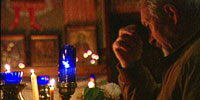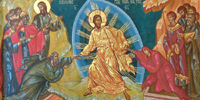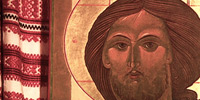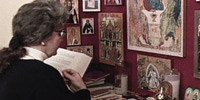Painting Icons
This week, Orthodox Christians mark the final days of Great Lent, a time of repentance, fasting, and prayer in preparation for Orthodox Easter, or Pascha, on May 5. Iconographer Seraphim O’Keefe talks about how icons play a role similar to fasting in the Orthodox tradition. Both, he says, are ways of finding order and beauty. The interview was filmed at Holy Cross Orthodox Antiochian Orthodox Church in Linthicum, Maryland, where O’Keefe has covered the walls with icons. Interview by Julie Mashack. Videography and editing by Patti Jette Hanley.
SERAPHIM O’KEEFE: It’s traditional to fast and pray as part of the process of painting icons and make an image that’s harmonious and ordered. The details are all serving the whole. Painting the icon is a way of praying using the paint, but it’s a prayer and it’s to manifest prayer. It shows prayer and it calls the people in the church to prayer. That’s the idea, is to have this concentrated, directed sense in the icon that people can respond to so that when you come into the church, your heart is lifted up in a way. Your whole…not just your heart and your eyes, your mind, and your body as one are immediately called to a higher place.
For most saints, the church has a tradition of making an icon of any given saint. And so the most important thing is to pay attention to what they look like and other icons. It’s not supposed to look like a naturalistic portrait of a person. It’s supposed to be in a way a transfigured person—the light is coming from inside. But through the process of painting here I have come to believe that they do look like the person depicted.
Sometimes I’ll be working and I’ll try to imitate the tradition of how a particular saint looked, and I’ll be failing miserably. And I feel like, maybe on every one of them, there’s a time when I feel like the saint steps in and gives some guidance. And then I’ll stand back and say, “Oh this actually looks like the tradition of how this person looks. You know, that’s him.”





